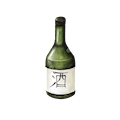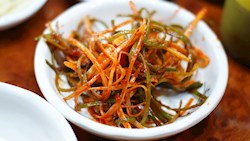TABLE OF CONTENTS
Best Korean Foods
MAIN INGREDIENTS
In the 1970s and 1980s, the fried chicken industry in South Korea expanded with the emergence of various fried chicken restaurant chains. These chains started experimenting with different flavors and sauces, moving beyond the original, stripped-down version of fried chicken.
MAIN INGREDIENTS
Yukhoe is the Korean version of steak tartare, consisting of thinly sliced beef marinated in soy sauce, sesame oil, garlic, and sugar. The concoction is then seasoned with salt and pepper. The dish is always served with a raw egg yolk on top, while thinly sliced Korean pear is an often-seen addition served on the side.
The name of the dish is derived from two words: yuk, meaning meat, and hoe, meaning sashimi. No one is yet sure about the origins of yukhoe, but some say it originated in China, while the others claim it was first served at the Korean Royal Court.
Samgyeopsal is a South Korean delicacy consisting only of pork belly, the most expensive cut of pork in the country. It is so popular in South Korea that the residents eat it approximately once every four days. The name of the dish consists of three words: sam (three), gyeop (layered), and sal (meat), so it can be literally translated as three-layered meat, referring to the three visible layers of the meat.
It is believed that the dish became popular in the 1960s, when the price of soju decreased and people needed a dish to go with it, so they chose pork belly due to its low price at the time. Whether at home or in restaurants, samgyeopsal is traditionally cooked at the table in a special pan which is designed to let the fat run off the sides of it.
OTHER VARIATIONS OF Gui
MOST ICONIC Samgyeopsal
View moreMAIN INGREDIENTS
In the American, French, German, Brazilian, and Korean systems of primal beef cuts, the tenderloin is a cut from the loin, which is located towards the back of the cow, nestled under the ribs, next to the backbone. It spans two primal cuts: the short loin and the sirloin.
The tenderloin is one of the most tender cuts of beef as it comes from a muscle that doesn't get much exercise. It is also one of the most highly prized and correspondingly expensive cuts of beef, due to its tenderness and flavor. Given the tenderness of this cut, the tenderloin is often cooked quickly over high heat, with methods such as grilling or broiling.
Bossam is a South Korean dish consisting of sliced and steamed pork that is wrapped in leaves of vegetables such as chard, beetroot, lettuce, or Chinese cabbage. When properly prepared, the meat should have a delicately smooth, creamy taste. It is often accompanied by rice, sweet kimchi, and shrimp sauce.
The dish is traditionally served as anju, denoting dishes that go well with alcoholic beverages. Bossam is a classic example of a simple dish that really comes together with the addition of numerous condiments and toppings, so many restaurants like to serve it with side dishes such as kimchi stew, dwenjang jjigae, or seafood pancakes.
OTHER VARIATIONS OF Ssam
This South Korean classic consists of thinly sliced fatty pork cuts that are marinated and then grilled or pan-fried. The marinade is based on gochujang - a spicy Korean chili paste - and additions such as soy sauce, chili flakes, rice wine, garlic, and ginger.
Also known as dwaejigogi bokkeum, this pork dish is commonly prepared at home, and it is a staple at Korean restaurants. Jeyuk bokkeum is usually served with lettuce or perilla leaves that are meant to be used as wrappers, while other accompaniments include ssamjang and kimchi.
MAIN INGREDIENTS
Jeon, also known as Korean pancakes, represents a number of pancake-like dishes in Korean cuisine that are often served as appetizers, side dishes, or consumed as snacks. Although jeon are typically prepared in savory versions, there are also some sweet varieties of these flavorful pancakes.
At their simplest, it is food that is first coated in flour and eggs, then pan-fried in oil. Jeon incorporates ingredients such as thinly sliced meat, poultry, seafood, and various vegetables. The pancakes are traditionally prepared every year during the Korean Lunar New Year and Korean Harvest Festival, although they are eaten daily throughout the year.
OTHER VARIATIONS OF Banchan
MOST ICONIC Jeon
View moreMAIN INGREDIENTS
Dak galbi is the South Korean variety of stir-fried chicken. It is a communal dish that's cooked tableside, on large cast iron skillets. Typical elements in dak galbi include various chicken cuts, cabbage, tteok rice cakes, carrots, chili peppers, and sweet potatoes.
When served in restaurants, the server will bring all the ingredients and cook the dish for the guests. Occasionally, perilla leaves are incorporated into dak galbi, but the final addition is always a generous amount of spicy sauce made with spicy chili paste, chili flakes, soy sauce, garlic, ginger, and onions.
Kimchi jjigae is a flavorful Korean stew that employs kimchi as its base ingredient. Other elements usually include diced tofu, pork, or seafood, along with scallions and other vegetables such as potatoes or zucchinis. Kimchi stew is one of the most common dishes enjoyed in South Korea, and it is traditionally served as a communal meal, and should always be piping hot.
The dish is best prepared with older kimchi since it tends to impart more flavor to the stew. Kimchi jjigae is usually served with rice on the side, as well as other traditional Koran sides (banchan).
MOST ICONIC Kimchi jjigae
View moreMAIN INGREDIENTS
This gimbap (Korean rice roll) is made with canned tuna. Apart from rice and fish, the fillings may include other ingredients that are typically used in gimbap such as fresh or pickled vegetables, eggs, or fish cakes, while the tuna is often mashed and then combined with mayonnaise, mustard, and spices.
The roll is traditionally wrapped in toasted seaweed, and it is served sliced into small, bite-size pieces.
OTHER VARIATIONS OF Gimbap
TABLE OF CONTENTS
TABLE OF CONTENTS
TasteAtlas food rankings are based on the ratings of the TasteAtlas audience, with a series of mechanisms that recognize real users and that ignore bot, nationalist or local patriotic ratings, and give additional value to the ratings of users that the system recognizes as knowledgeable. For the “Top 100 Korean Foods” list until April 28, 2025, 5,925 ratings were recorded, of which 5,126 were recognized by the system as legitimate. TasteAtlas Rankings should not be seen as the final global conclusion about food. Their purpose is to promote excellent local foods, instill pride in traditional dishes, and arouse curiosity about dishes you haven’t tried.



























































































